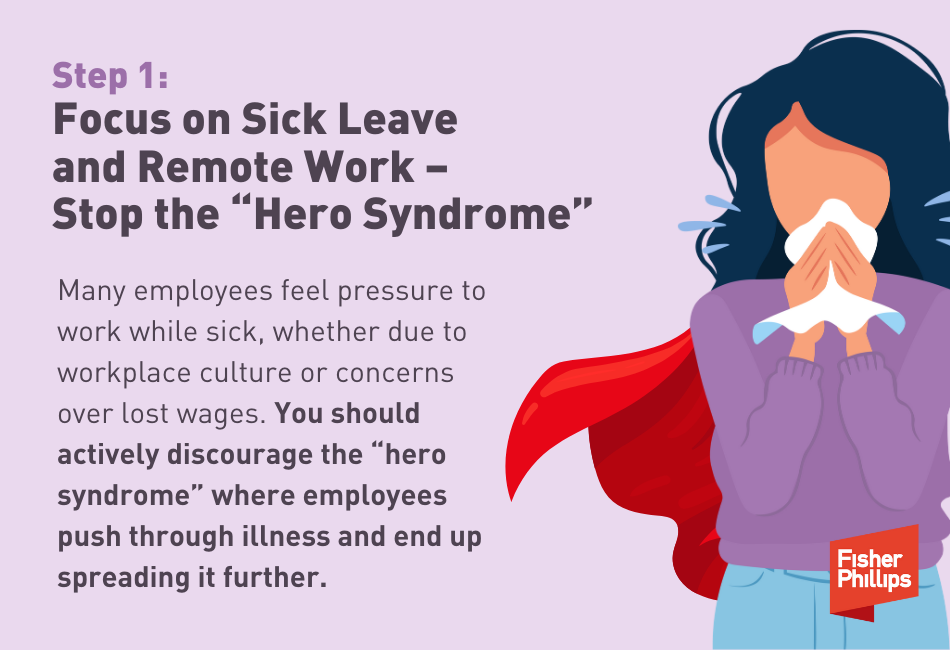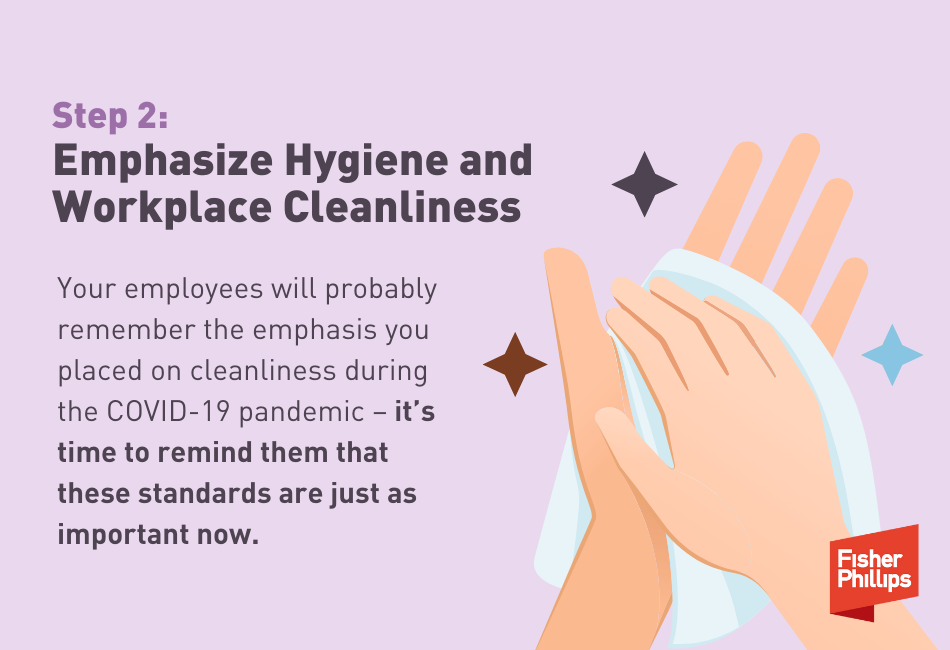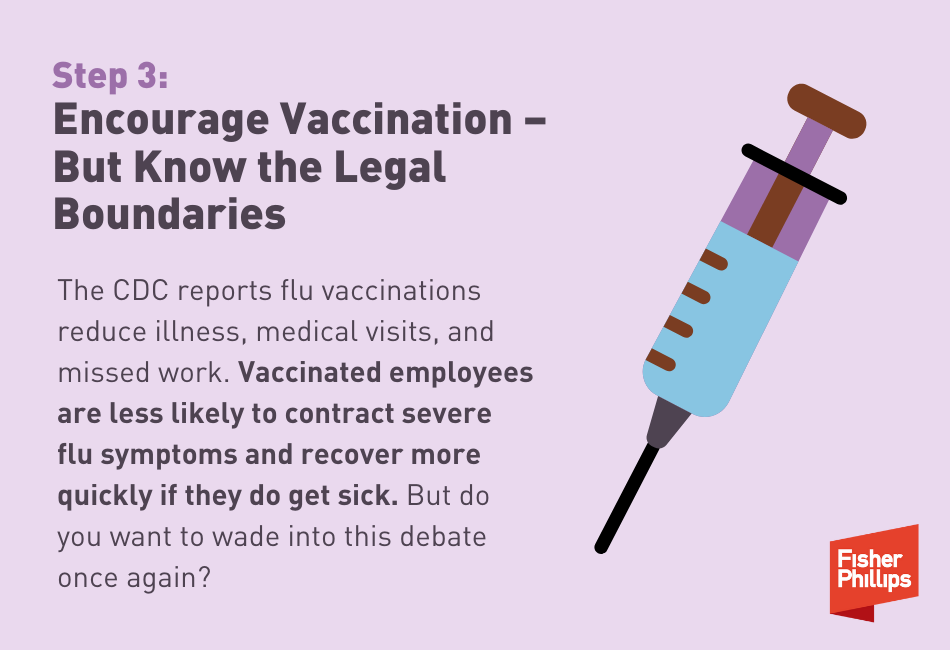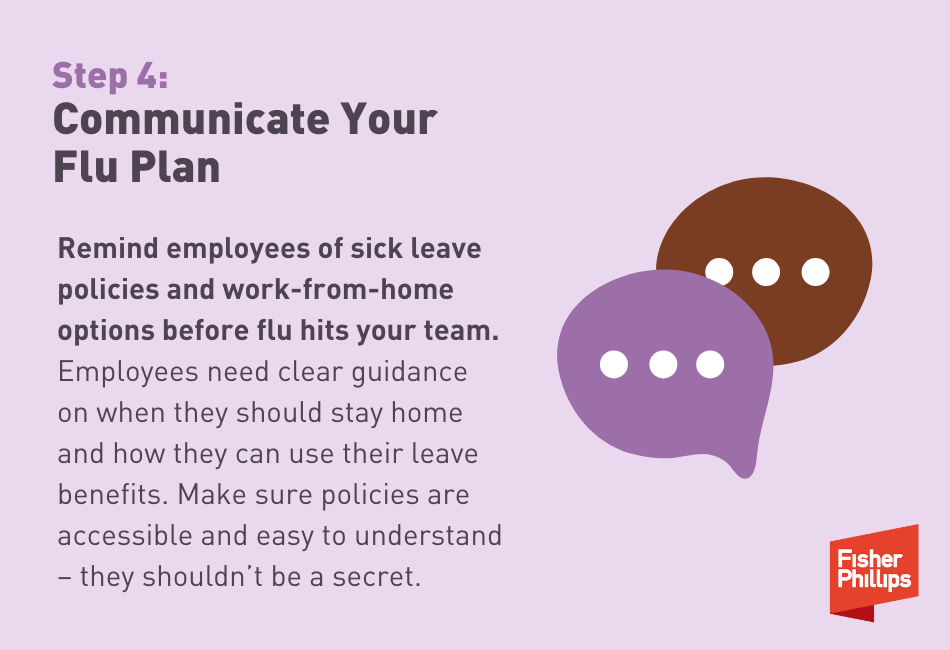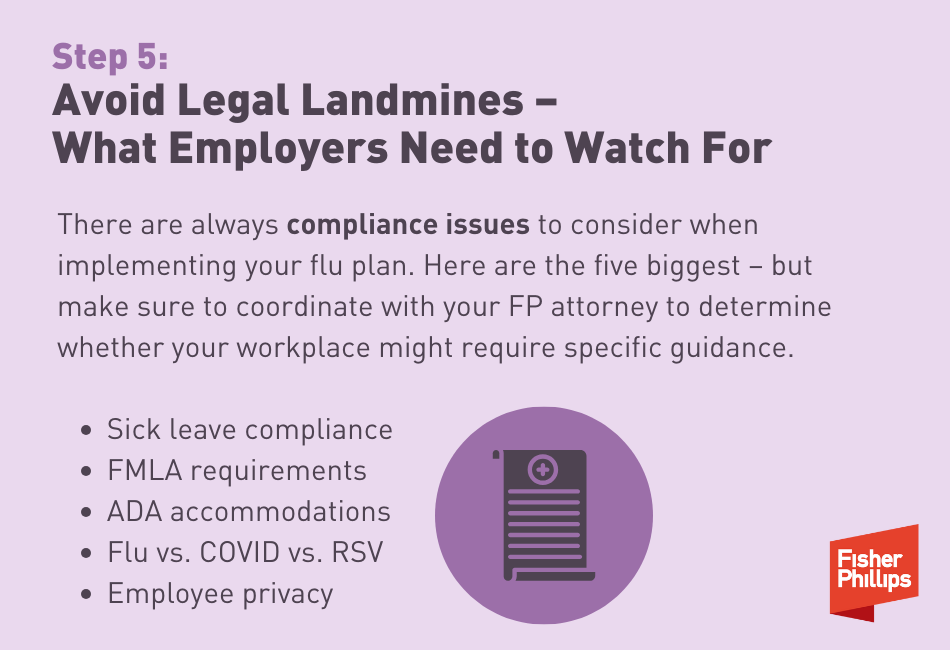Employers’ 5-Step Plan for Handling the Worst Flu Season in 15 Years
Insights
2.21.25
The U.S. is currently facing the worst flu season since 2009, and employers can’t afford to ignore it. Beyond the personal toll, flu outbreaks wreak havoc on businesses through lost productivity and absenteeism – and they can even present legal risks. The good news? A few strategic moves can help keep your workforce healthy and your operations running smoothly. Here is your five-step plan for handling the 2025 flu storm.
Quick Background
The United States is currently experiencing its most severe flu season since the 2009 H1N1 flu pandemic. As of early February, the Centers for Disease Control and Prevention (CDC) estimates there have been at least 29 million flu cases, at least 370,000 hospitalizations, and at least 16,000 deaths this flu season. This surge in flu-related hospitalizations has significantly strained healthcare systems nationwide, with certain regions, such as New York and California, reporting unprecedented levels of flu activity.
Health officials attribute this intense flu season to numerous factors such as low vaccination rates and the widespread circulation of two particularly virulent flu strains, the H1N1 and H3N2 strains. The flu virus spreads quickly in close-contact environments like offices, warehouses, and retail spaces, and in addition to being spread through the air like COVID-19, it can live for up to 48 hours on hard surfaces such as doorknobs and keyboards.
The good news is that employers can play a crucial role in mitigating the impact of this severe flu season by implementing commonsense, comprehensive workplace health strategies. Besides contributing to the overall public good, implementing workplace protections will help your bottom line. Flu symptoms can sideline employees for a week or more at a time, and the ripple effect of such a workplace outbreak can be a significant financial burden on employers with resulting productivity declines, missed deadlines, and the remaining employees being subjected to increased workloads as they are the ones left to pick up the slack, leading to potential burnout and further disruptions.
5-Step Plan
Employers should take a proactive stance when it comes to addressing the flu. By implementing effective flu prevention strategies, you can minimize absenteeism, maintain workplace morale, and ensure business continuity. Here’s your five-step plan to combat this year’s flu storm:
Step 1: Focus on Sick Leave and Remote Work – Stop the “Hero Syndrome”
Sick employees at work are a disaster. One worker can infect half an office in hours. Many employees feel pressure to work while sick, whether due to workplace culture or concerns over lost wages. You should actively discourage the “hero syndrome” where employees push through illness and end up spreading it further.
- Encourage (or mandate) sick employees to stay home: Remind employees that taking a sick day is a responsible decision that benefits the entire workforce. Consider providing remote work options where feasible. If an employee is well enough to work but still contagious, flexible work arrangements can keep things running without spreading illness.
- FLSA and other wage rules matter: If an exempt employee runs out of sick leave, you can make deductions – but only in full-day increments. For non-exempt employees, you should ensure compliance with any local and state paid sick leave laws. Some states have expanded sick leave laws requiring employers to provide a certain amount of paid time off for illness.
- Plan for absenteeism: You should assess your staffing levels and create contingency plans for potential shortages. Cross-training employees and having backup plans in place can help mitigate disruptions if multiple team members fall ill.
Step 2: Emphasize Hygiene and Workplace Cleanliness
Your employees will probably remember the emphasis you placed on cleanliness during the COVID-19 pandemic – it’s time to remind them that these standards are just as important now.
- Offer handwashing reminders: Post signs, stock up on soap, and consider touchless dispensers. Hand hygiene is one of the most effective ways to prevent flu transmission. You should provide accessible handwashing stations and hand sanitizers in high-traffic areas.
- Disinfect shared spaces: Hard surfaces such as keyboards, phones, doorknobs – these are flu hotspots. Studies show that flu viruses can live on hard surfaces for up to 48 hours, making regular sanitization crucial. Increase the frequency of cleaning in communal areas, including break rooms and conference rooms.
- Rethink the office layout: If flu is spreading, consider temporary spacing adjustments or rotating schedules. In open-office environments, increasing physical distance between workstations and implementing staggered shifts can help minimize exposure.
- Provide personal protective equipment (PPE): In some workplaces, offering disposable masks and sanitizing wipes can reduce virus transmission, especially in customer-facing roles.
Step 3: Encourage Vaccination – But Know the Legal Boundaries
The CDC reports flu vaccinations reduce illness, medical visits, and missed work. Vaccinated employees are less likely to contract severe flu symptoms and recover more quickly if they do get sick. But do you want to wade into this debate once again? Here are the legal (and practical) benefits you should keep in mind as you consider vaccinations.
- Can you require flu shots? In most cases, yes – but first determine whether your company needs to implement such a policy (for example, healthcare settings have a much easier case to make than other workplaces). And of course, be prepared for exemption requests based on medical or religious beliefs. Employers that mandate flu shots must ensure compliance with federal anti-discrimination laws, including the Americans with Disabilities Act (ADA) and Title VII of the Civil Rights Act. Offering reasonable accommodations, such as requiring mask-wearing or remote work instead of vaccination, can help avoid legal pitfalls.
- Alternative approaches: On-site flu shot clinics, incentives like gift cards, or simple education campaigns can also help encourage the vaccine rather than mandating it. Many employees opt out of the flu shot due to convenience issues, so bringing the vaccine to them can increase participation. You can also cover the cost of flu shots at local pharmacies to encourage more employees to get vaccinated.
- Communicate the benefits: You can educate employees on how flu shots not only protect the individual but also help shield vulnerable coworkers and their families. Making vaccination part of an overall wellness initiative can increase participation rates.
Step 4: Communicate Your Flu Plan
Remind employees of sick leave policies and work-from-home options before flu hits your team. Employees need clear guidance on when they should stay home and how they can use their leave benefits. Make sure policies are accessible and easy to understand – they shouldn’t be a secret.
- Keep it simple: A one-pager on flu prevention and company expectations can go a long way. A straightforward communication strategy that includes email reminders and workplace posters reinforces best practices.
- Train managers: They’re the first line of defense – empower them to send sick employees home without hesitation. Supervisors should be instructed on how to recognize flu symptoms and how to handle situations where employees come to work sick.
- Foster a supportive culture: Employees should feel comfortable taking sick leave without fear of reprisal. Encouraging open conversations about health and well-being can reduce stigma and make it easier for employees to prioritize their health.
Step 5: Avoid Legal Landmines – What Employers Need to Watch For
There are always compliance issues to consider when implementing your flu plan. Here are the five biggest – but make sure to coordinate with your FP attorney to determine whether your workplace might require specific guidance.
- Sick leave compliance: A growing number of states are requiring employers to provide paid sick leave or expanding their existing sick leave laws to cover more employers and provide greater protections to employees. (Take, for example, a Connecticut law that just took effect January 1, a Michigan law set to take effect Feb. 21 despite lawmakers rushing to push through some changes, and a voter-initiated Missouri law that kicks in May 1). Some state laws entitle employees to use accrued paid sick leave to care for a sick family member, which can be defined broadly to include individuals far beyond the employee’s spouse or minor child. Noncompliance with these laws can result in penalties, so review your policies now – and annually – to ensure they align with current regulations.
- FMLA requirements. While a flu diagnosis alone might not qualify as a “serious” health condition protected by the federal Family and Medical Leave Act, the flu can become a protected condition if it causes an FMLA-eligible employee or their covered family member to be incapacitated for more than three consecutive, full calendar days and to seek follow-up treatment meeting certain conditions. You can read more about the FMLA’s “incapacity plus treatment” protections in this fact sheet from the U.S. Department of Labor.
- ADA accommodations: Employees with high-risk conditions may need additional protections. The flu can be particularly dangerous for employees with compromised immune systems or chronic conditions. You may need to provide reasonable accommodations under the ADA.
- Flu vs. COVID vs. RSV: Multiple viruses mean evolving policies. With COVID-19 and RSV still in circulation, you should have flexible and adaptive policies that address multiple infectious diseases. Consider updating company policies to reflect best practices for respiratory illness prevention.
- Employee privacy: If an employee tests positive for the flu, you should handle health information confidentially, in compliance with HIPAA and other applicable privacy laws.
Conclusion – Your Workplace Flu Game Plan Starts Now
Flu season isn’t a maybe – it’s happening right now, and employers who ignore flu preparedness risk major disruptions to their operations. A proactive approach protects your workforce and keeps your business running smoothly. By implementing effective flu prevention strategies and sound workplace policies now, employers will avoid bigger problems later.
We will continue to monitor developments in this area and provide updates as warranted. Make sure you are subscribed to Fisher Phillips’ Insight System to get the most up-to-date information. If you have any questions, contact the author of this Insight, your Fisher Phillips attorney, or any member of our Workplace Safety Practice Group.
Related People
-
- John Rogers
- Of Counsel
